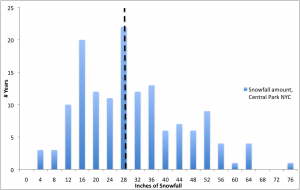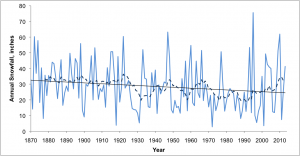It’s been a bit snowy in NYC this winter, and more is on the way. Just for fun, I took a quick peek at NYC snowfall data for Central Park, which goes back to 1868. Here’s some interesting info:

Average snowfall for the season (Sept-April) is 28.5 inches, with a standard deviation of 14.81 inches. Median snowfall is 27 inches.
This winter we’re already above average with 41.3 inches (that’s assuming that yesterday’s snowfall was 5 inches – the data wasn’t available). This puts us in roughly the 80th percentile for the entire winter. February is historically the snowiest month, and with the storm(s) on the way this weekend, the totals will increase. And we can also look forward to March and April, where, historically, about 25% of the yearly snowfall happens.

But so far, this is not the snowiest winter. That record belongs to 1995-96, with 75.6 inches of snow, which is an extreme outlier. The next most is 63.2, and only 5 years have had snowfall in excess of 60 inches. 16 winters had less than a foot of snow. There’s a bit of a downward trend in the snowfall data, although a 10-year moving average indicates that there’s quite a bit of internal variability. The 90’s and 2010’s (so far… not a good estimate!) have very high decadal standard deviations, and the 2000’s is higher than any decade before 1990 except the 1870s. Hrm – I might need to do some ENSO correlation here!
References:
1. NOAA Climate records: http://www.erh.noaa.gov/okx/climate/records/monthseasonsnowfall.html
2. NOAA US Daily snowfall and snow depth data, http://www1.ncdc.noaa.gov/pub/data/snowmonitoring/fema/01-2014-dlysnfl.txt
Comments by grustic